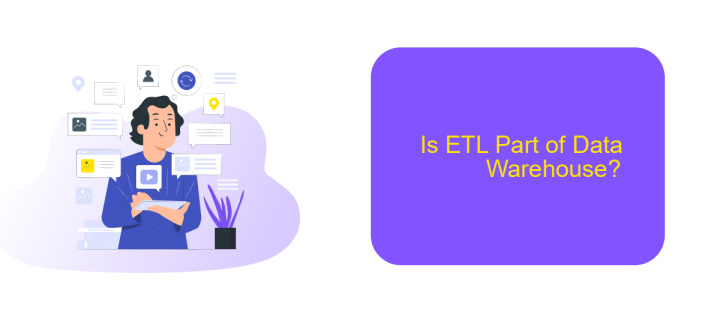Is ETL Part of Data Warehouse
Extract, Transform, Load (ETL) processes are fundamental components of data warehousing. They enable the efficient collection, transformation, and loading of data from various sources into a centralized repository. This article explores whether ETL is an integral part of data warehousing, examining its roles, benefits, and the evolving landscape of data management technologies.
Introduction
The process of managing and analyzing data has become crucial for businesses aiming to make informed decisions. One of the key components in this process is the data warehouse, a centralized repository for storing and managing large volumes of data from various sources. A common question that arises is whether ETL (Extract, Transform, Load) is an integral part of a data warehouse. ETL plays a significant role in preparing data for analysis, but its relationship with data warehouses can be more nuanced.
- Extract: The process of retrieving data from various sources.
- Transform: The process of converting data into a suitable format for analysis.
- Load: The process of loading transformed data into the data warehouse.
Understanding the role of ETL in the data warehousing process is essential for optimizing data management strategies. Services like ApiX-Drive can simplify the integration of data sources, ensuring seamless and efficient data flow into your data warehouse. This article explores the relationship between ETL and data warehouses, highlighting the importance of each component in the broader context of data management.
What is ETL?

ETL, which stands for Extract, Transform, Load, is a fundamental process in data warehousing and data integration. During the extraction phase, data is collected from various sources such as databases, APIs, and flat files. This data is then transformed to align with the target schema, ensuring it is clean, consistent, and formatted correctly. The final step, loading, involves moving the transformed data into a data warehouse or another target system where it can be used for analysis and reporting.
Effective ETL processes are crucial for maintaining data quality and integrity. Tools and services like ApiX-Drive can simplify the setup and management of ETL workflows. ApiX-Drive allows users to connect various data sources and automate the data flow between them, making it easier to integrate and manage data from multiple platforms. This not only saves time but also reduces the risk of errors, ensuring that the data in the warehouse is always up-to-date and reliable.
What is a Data Warehouse?

A data warehouse is a centralized repository that stores large volumes of data from various sources. It is designed to support business intelligence activities, including reporting, data analysis, and decision-making. By consolidating data from multiple systems, a data warehouse provides a unified view of information, making it easier for organizations to gain insights and drive strategic actions.
Key features of a data warehouse include:
- Data Integration: Combines data from different sources into a coherent dataset.
- Historical Data Storage: Maintains historical data for trend analysis and forecasting.
- Query Performance: Optimized for complex queries and high-speed data retrieval.
- Data Quality: Ensures data consistency, accuracy, and reliability.
To streamline data integration, tools like ApiX-Drive can be utilized. ApiX-Drive allows seamless connection and synchronization between various applications and services, ensuring that data flows smoothly into the data warehouse. This automation reduces manual effort and enhances data accuracy, enabling businesses to focus on analyzing and utilizing their data effectively.
Is ETL Part of Data Warehouse?

ETL, which stands for Extract, Transform, Load, is a crucial process in the data warehousing ecosystem. It involves extracting data from various sources, transforming it into a suitable format, and loading it into a data warehouse. This process ensures that data is clean, consistent, and ready for analysis.
Data warehouses rely on ETL processes to integrate data from disparate sources, making it accessible for business intelligence and analytics. Without ETL, the data in a warehouse would be unstructured and difficult to use effectively. Therefore, ETL is an integral part of any data warehousing strategy.
- Extraction: Collecting data from multiple sources.
- Transformation: Cleaning, validating, and formatting the data.
- Loading: Inserting the transformed data into the data warehouse.
For organizations looking to streamline their ETL processes, services like ApiX-Drive can be invaluable. ApiX-Drive offers seamless integration capabilities, enabling automated data transfers between various systems and the data warehouse. This not only saves time but also reduces the risk of errors in the ETL process.


Conclusion
In conclusion, the role of ETL in the data warehouse ecosystem is indispensable. ETL processes are crucial for extracting data from various sources, transforming it into a suitable format, and loading it into the data warehouse for analysis and reporting. This integration ensures that businesses can make informed decisions based on accurate and timely data. Without ETL, the efficiency and effectiveness of data warehouses would be significantly compromised, leading to potential data silos and inconsistencies.
Moreover, modern tools and services like ApiX-Drive have made it easier to set up and manage ETL processes. ApiX-Drive offers seamless integration capabilities, allowing businesses to connect various data sources without extensive technical expertise. This not only streamlines the data integration process but also enhances the overall functionality and reliability of data warehouses. As data continues to grow in volume and complexity, the importance of efficient ETL processes and reliable integration services will only increase, solidifying their place as an integral part of the data warehouse infrastructure.
FAQ
Is ETL Part of Data Warehouse?
What are the main steps in the ETL process?
Why is ETL important for a data warehouse?
Can ETL processes be automated?
What are some common challenges in ETL for data warehouses?
Routine tasks take a lot of time from employees? Do they burn out, do not have enough working day for the main duties and important things? Do you understand that the only way out of this situation in modern realities is automation? Try Apix-Drive for free and make sure that the online connector in 5 minutes of setting up integration will remove a significant part of the routine from your life and free up time for you and your employees.

